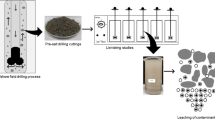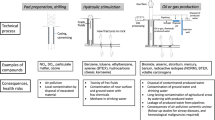Abstract
Samples of new oil-based drilling fluid (NOBDF) and circulating oil-based drilling fluid (COBDF) in Chongqing were tested and analyzed to evaluate the possible impact of oil-based drilling fluid (OBDF) on human health and ecological environment. Organic matter, metals, and naturally occurring radionuclide materials (NORMs) in OBDF samples were analyzed and determined by gas chromatography-mass spectrometry, high-performance liquid chromatography, PANalytical Axios Fast XRF spectrometer, and gamma ray spectrometer. The results revealed that the contents of trace metals and NORMs in OBDF were less, which would not cause local ecological risk or health risk to the drilling crew. However, the concentrations of various aromatics analyzed in OBDF were very high, which was easy to pose serious environmental and health hazards. There were 8 aromatic hydrocarbons (AHs) in NOBDF and 15 AHs in COBDF. And the total carcinogenic risk value of each aromatic hydrocarbon was far greater than 10–4, which belonged to an unacceptable level. In addition, the inhalation pathway seemed to be the most significant source of carcinogenic risk, accounting for 99% of the total carcinogenic risk. Meanwhile, it is recommended to equip drilling workers with gas masks and develop all-oil biodiesel drilling fluid.










Similar content being viewed by others
References
Administration of Quality and Technology Supervision, 2016. Technical guidelines for site environmental investigation and risk assessment, Chongqing, China, DB50/T 725–2016.
China, Ministry of Ecology and Environment, 2019. Annual report of the national radiation environment, Beijing, 55–56.
Cauchi, G. 2004. Skin rashes with oil based mud derivatives. In: SPE International Conference on Health safety and Environment in oil and gas exploration and production, Calgary, Alberta, Canada, SPE 86865. 1-2.
Chen, H., Teng, Y., Lu, S., et al. (2016). Source apportionment and health risk assessment of trace metals in surface soils of Beijing metropolitan, China. Chemosphere, 144, 1002–1011.
China, State Bureau of Quality and Technical Supervision, 2015. Petroleum Liquids—manual sampling. Beijing, GB/T 4756-2015, 1-17.
China, Ministry of ecology and Environment, State Administration of Market Supervision and Administration, 2018a. Soil environmental quality standard—Risk control standard of agricultural land soil pollution (Trial), GB15618-2018a,1–10.
China, Ministry of Ecology and Environment, State Administration of Market Supervision and Administration, 2018b. Soil environmental quality standard—Risk control standards for soil pollution of construction land (Trial), GB36600-2018b,1–10.
China, Ministry of ecology and environment, National Development and Reform Commission, Ministry of public security, Ministry of transport, National Health Commission, 2021. National Catalogue of Hazardous Wastes. 2021 Edition: 8–9, HW08, 071–001–08 &072–002–08.
China, Ministry of environmental protection. (2014). Technical guidelines for risk assessment of contaminated sites. Beijing, HJ, 25(3–2014), 1–10.
Emmanuel, E. O., Chidiebere, O., Samuel, E. S., et al. (2020). Risk assessment of human exposure to radionuclides and heavy metals in oil-based mud samples used for drilling operation. International Journal of Environmental Health Research. https://doi.org/10.1080/09603123.2020.1811843
Gardner, R. (2003). Overview and characteristics of some occupational exposures and Health risks on offshore oil and gas installations. Annals of Occupational Hygiene, 3, 201–210.
Gbadebo, M. A., Taiwo, M. A., & Eughele, U. (2010). Environmental aspect of oil and water-based drilling muds and cuttings from Dibi and Ewan off-shore wells in the Niger Delta, Nigeria. African Journal of Environmental Science and Technology, 4(5), 284–292.
Genuino, H. C., Horvath, D. T., King’Ondu, C. K., et al. (2012). Effects of visible and UV light on the characteristics and properties of crude oil-in-water (O/W) emulsions. Photochemical & Photobiological Sciences Official Journal of the European Photochemistry Association & the European Society for Photobiology, 11(4), 692.
Gillis, B. S., Arbieva, Z., & Gavin, I. M. (2012). Analysis of lead toxicity in human cells. BMC Genomics, 13, 344.
He, M., Zhang, S., Zhang, C., et al. (2018). Effect of drilling and thermal desorption process on the change of mineral oil compositions in oil-based mud. Journal of Environmental Engineering Technology, 8(3), 290–296.
Ikeh, O. A. (2014). Contributions of petroleum drilling mud to environmental pollution assessment of heavy metals and polycyclic aromatic hydrocarbons in oil-based petroleum drilling mud (pp. 62–69). Nsukka: University of Nigeria.
Jagwani, D., Shukla, P., Kulkarni, A., et al. (2011). Organ specific distribution of PAHs in a carnivorous fish species following chronic exposure to used synthetic-based drilling mud. Polycyclic Aromatic Compounds, 31(4), 227–242.
Jones F V, Rushing J. H., Churan M. A., 1991. The chronic toxicity of mineral oil wet and synthetic liquid wet cuttings on an estuarine fish. In: SPE Health, Safety and Environment in Oil and Gas Exploration and Production Conference. The Hague.https://doi.org/10.2118/23497-MS.
Leonard, S. A., & Stegemann, J. A. (2010). Stabilization/solidification of petroleum drill cuttings: Leaching studies. Journal of Hazardous Materials, 174(1), 484–491.
Lin, L., Xu, Y., Zhang, J. C., et al. (2019). Risk analysis of shale gas exploration and development. China Mining Magazine, 11, 59–64.
Lippmann, M., Ito, K., Hwang, J. S., et al. (2006). Cardiovascular effects of nickel in ambient air. Environmental Health Perspectives, 114(166214), 16.
Liu, X., Song, Q., Tang, Y., et al. (2013). Human health risk assessment of heavy metals in soil-vegetable system: A multi-medium analysis. Science of the Total Environment, 463–464, 530–540.
Liu, Y., Yuan, J., Xu, J., et al. (2015). Regeneration experimental research of diesel separated from abandoned oil-based fluid. Acta Petroleisinica ( Petroleum Processing Section), 3, 776–781.
McDougal, J. N., Pollard, D. L., Weisman, W., Garrett, C. M., & Miller, T. E. (2000). Assessment of skin absorption and penetration of JP-8 jet fuel and its components. Toxicological Sciences, 55(2), 247–255.
OGP and IPIECA. (2009). Drilling fluids and health risk management—A guide for Drilling personnel, managers and health professionals in the oil and gas industry. International Associated of Oil and Gas Producers (OGP). International Petroleum Industry Environmental Conservation Association., 342, 390–396.
Qi, X. B., Wu, J., Wang, M., et al. (2017). Composition distribution and ecological risk assessment of PAHs in water from oil spill to tidal marshes. Environmental Science & Technology, 3, 172–177.
Razalia, S. Z., Yunusa, R., Suraya, A. R., Limc, H. N., & Mohamed, J. B. (2018). Review of biodegradable synthetic-based drilling fluid: Progression, performance and future prospect. Renewable Sustainable Energy Rev., 90, 171–186.
Salah, M. A. (2016). Environmental impact of disposal of oil-based mud waste in Kuwait. Petroleum Science and Technology, 34(1), 91–96. https://doi.org/10.1080/10916466.2015.1122630
Sayle S., Seymour M. A., Whitford E. H., 2002. Assessment of environmental impacts from drilling muds and cuttings disposal, offshore brunei. SPE 73930. In: Presented at the SPE International Conference on Health, Safety and Environment in Oil and Gas Exploration and Production, held in Kuala Lumpur, Malaysia; 20–22.
Siddique, S., Kwoffie, L., Addae-Afoakwa, K., et al. (2017). Oil based drilling fluid waste: An overview on environmentally persistent pollutants. IOP Conference Series: Materials Science and Engineering, 195(1), 12008–012009.
Song, W., Liu, J., & Nie, Y. (2008). Comparative study of pyrolysis and combustion process of oil sludge by TG -FTIR analysis. Journal of Tsinghua University ( Sci & Tech), 48(9), 1453–1457.
Wang, H. L., Rao, W., Luo, M. D., & Yu, Q. (2019). Investigation on Natural Radioactivity Level of Wastewater from Shale Gas Exploitation in Longmaxi Formation of Sichuan Basin. Sichuan Environment, 38(2), 86–89.
Wang, W., & Kannan, K. (2019). Quantitative identification of and exposure to synthetic phenolic antioxidants, including butylated hydroxytoluene, in urine. Environment International, 128, 24–29.
Wu, X. H., Yue, B., Su, Y., et al. (2016). Pollution characteristics of BTEX in common used mineral oils and their transformation during oil regeneration. Acta Scientiae Circumstantiae, 36(11), 4120–4126.
Xu, H., Han, S., Bi, X., et al. (2016). Atmospheric metallic and arsenic pollution at an offshore drilling platform in the Bo Sea: A health risk assessment for the workers. Journal of Hazardous Materials, 304, 93–102.
Xu, T. T., Wang, L. A., Wang, X., Li, T., & Zhan, X. Y. (2018). Heavy metal pollution of oil-based drill cuttings at a shale gas drilling field in Chongqing, China: A human health risk assessment for the workers. Ecotoxicology and Environmental Safety, 165, 160–163.
Zhang, L., Ye, F., Wang, J., et al. (2015). The eco-environmental characteristics and variation trends around Chengdao oil field sea areas in the Yellow River Estuary. Journal of Marine Sciences, 33(3), 75–83.
Acknowledgements
This research is supported by Chongqing technological innovation and application development project (Grant No. cstc2018jszx-zdyfxmx0011) and Chongqing Natural Science Foundation project (Grant No. cstc2019jcyj-msxmx0651). Thanks go to Dr. Xu Han and the reviewers for their valuable opinions, which greatly improved the quality of the paper.
Funding
This research was supported by “Study on raw material substitution technology for monitoring and evaluation of drilling cuttings landfill tank and collaborative disposal of landfill body cement kiln” (Grant No. cstc2019jcyj-msxmX0651).
Author information
Authors and Affiliations
Contributions
DX: Framework design and experiments, data and relevant mechanism analysis, writing-original draft, writing-review, revised and editing. XH: Assisting with research, experiments and data analysis.
Corresponding author
Ethics declarations
Conflict of interest
The authors declare that they have no known competing financial interests or personal relationships that could have appeared to influence the work reported in this paper.
Consent to Publish
All authors agreed to publish the article.
Consent to Participate
Nobody participated in the human or animal experiment.
Ethical Approval
Any experimental research on animals should follow the internationally recognized guidelines. However, in this study, we did not conduct any human or animal experiments, so we do not need the moral consent of the relevant departments.
Additional information
Publisher's Note
Springer Nature remains neutral with regard to jurisdictional claims in published maps and institutional affiliations.
Rights and permissions
About this article
Cite this article
Xiong, D., Han, X. Particular pollutants, human health risk and ecological risk of oil-based drilling fluid: a case study of Fuling shale gas field. Environ Geochem Health 45, 981–995 (2023). https://doi.org/10.1007/s10653-022-01259-z
Received:
Accepted:
Published:
Issue Date:
DOI: https://doi.org/10.1007/s10653-022-01259-z




